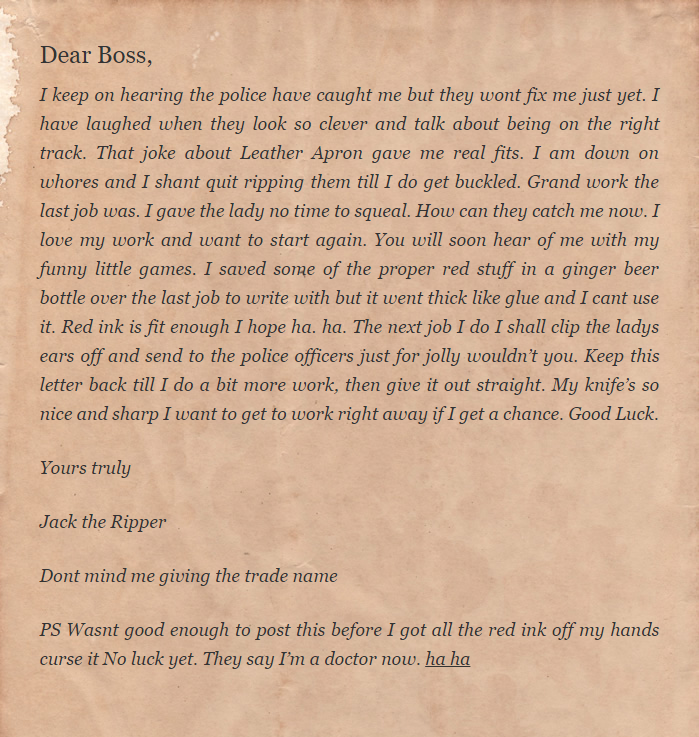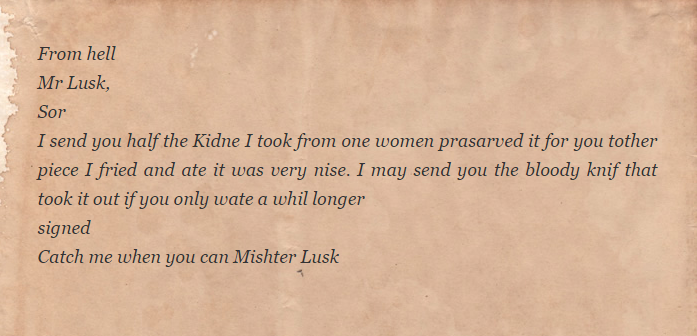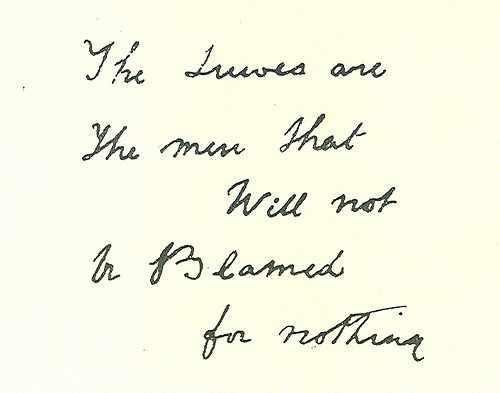The Jack the Ripper Letters
Hundreds of letters were received during the hysteria surrounding the Whitechapel murders. Nearly all of them were written by cranks but one or two may have been genuine. 'Jack the Ripper' has not been mentioned so far in this account as this name was not known to the public until after 'The Double Event'. The name 'Jack the Ripper' originated in what is known as the 'Dear Boss' letter which was written in red ink. It was received by the Central News Agency on 27th September, passed on to the police and printed in newspapers on 1st October. It is widely believed to be a hoax designed to sell newspapers. It certainly popularised the name 'Jack the Ripper'.


Soon after a blood Stained postcard was received by the Central News Agency, in similar hand writing to the 'Dear Boss' letter The 'Saucy Jack' postcard coined the term 'double event'. As it was received on the 1st October it may have been posted prior to the murders taking place. Furthermore, the 'Dear Boss' letter referred to ears being cut off, and Catherine's ears had been cut.
George Lusk was the president of the Whitechapel Vigilance Committee, which had been set up to patrol the streets of the East End. On October 16th a small cardboard box was posted to him. Inside was half a kidney -along with a letter. Catherine's left; kidney's had been removed by Jack the Ripper. Tests showed that Lusk's grisly gift was recent left kidney from a woman. It possibly had Other characteristics in common with Catherine's right kidney and because of this, the 'from Hell' letter is widely believed to be genuine.


Catherine's murder had taken place in the City of London, Which had its own separate police force. The other murders had taken place under the jurisdiction Of the Metropolitan Police. At 2.55 am PC Long was on the beat. It was his first night in Whitechapel. He was a Metropolitan policeman normally stationed in the Dwellings on Goulston Street, Long found a piece of a bloodied cloth. He then noticed on the black brickwork immediately above the cloth, a message written in chalk letters 3/4 inch high.
Long recorded what it said: 'The Juwes are the men That Will not be Blamed for nothing' This was on the second doorway down from Wentworth Street, which is today part of the Happy Days Fish Restaurant. There are several curious anomalies to Long's story. Firstly, he says that when he found the cloth he did not know that Catherine had been murdered over an hour previously just five minutes walk away.
Secondly. he says that when he passed the stairwell at 2.20 am he did not see anything. If he was telling the truth (and was not shirking) then it implies that the murderer lingered for at least half an hour, rather than flee to a place of safety... unless.he lived near-by. Thirdly, a City of London Detective called Halse was searching the area after the discovery Of Catherine's body. Halsey passed down Goulston Street at 2.20 am but did not bump into Long.
It is interesting to note that ten months later Long was discharged from the police for being drunk on duty. The cloth was the first real clue left by the murderer It was taken to Leman Street Police Station and was found to fit exactly a missing piece of Catherine's apron. Soon senior policemen converged on Goulston Street and immediately an argument broke out between the City Police and the Metropolitan Police. The City Police wanted the graffiti to be photographed. They claimed an interest as the apron was directly linked to the murder Of Catherine, in their jurisdiction. However, the Metropolitan police said it should be washed off the wall to prevent members of the public from reading it in case it provoked an anti-Jewish riot.
Most residents in Goulston Street were Jewish, but traders from Petticoat Lane market were already walking past the doorway to set up their stalls. As the writing was small and inside the doorway, it seems that it would not have been difficult for a policeman to stand in front of the graffiti until the photograph could be taken. For whatever reason, Sir Charles Warren, the Commissioner of the Metropolitan Police, appeared and personally ordered that the graffiti be removed immediately Warren was roundly condemned this action, which made the police more sensitive to criticism.
As Lizzie had been murdered next to a Jewish club and the killer had been disturbed by Diemschutz and possibly also by Schwartz. both of whom were Jewish, it is possible that the message was left in theisJewish neighbourhood to throw the police off the scent. It is also possible that the graffiti written by someone else and the apron was left there by coincidence. Nevertheless it was undoubtedly the case that the murderer had left the apron. This surely indicated the route taken back to wherever he lived.


